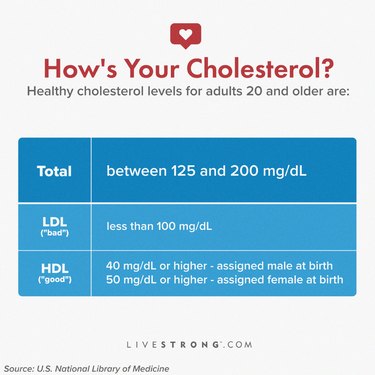
Cholesterol has a bit of a bad reputation, which is why there are plenty of high cholesterol statistics out there. But contrary to popular opinion, this waxy, fat-like substance isn't actually "bad," according to the American Heart Association.
In fact, your body needs cholesterol to build healthy cells, make vitamins and produce certain hormones. So cholesterol is a good thing — until there's too much of it.
Video of the Day
Video of the Day
Let's back up for a second. There are two main types of cholesterol: LDL or "bad" cholesterol, which builds up in the walls of the arteries, and HDL or "good" cholesterol, which helps shuttle extra cholesterol from the arteries back to the liver.
The problem comes when your "bad" cholesterol levels get too high, increasing your risk for heart disease, heart attack and stroke.
Read on to learn more high cholesterol statistics and facts about high cholesterol to help you better understand this condition, including who is most affected by it.

High Cholesterol Statistics Worldwide
In 2008, 39 percent of adults around the world had high total cholesterol, according to the World Health Organization (WHO), including:
- 40% of people assigned female at birth (AFAB)
- 37% of people assigned male at birth (AMAB)
Prevalence by Region
According to the WHO, high total cholesterol — as defined by more than 5 mmol/L (that's millimoles per liter, a common cholesterol measurement outside the U.S.) — affects:
- 23.1% of adults in Africa
- 30.3% of adults in South East Asia
- 36.7% of adults in the Western Pacific
- 38.4% of adults in the Eastern Mediterranean
- 47.4% of adults in the Americas
- 53.7% of adults in Europe
Mortality Rate of High Cholesterol
High cholesterol is a risk factor for heart disease and stroke, and a major cause of health, financial and economic disabilities throughout the world, according to the WHO.
High cholesterol death statistics globally include:
- High cholesterol is estimated to cause 4.5% of total deaths.
- In 2017, high LDL cholesterol was the fifth leading risk factor for death, according to a January 2020 report in Circulation, accounting for 4.3 million deaths.
- About 1 in 3 deaths from coronary heart disease is due to high cholesterol.
Tip
There are no symptoms of high cholesterol, according to the Mayo Clinic, so the only way to know if your levels are too high is by getting them checked with a blood test.
High Cholesterol Demographics for the U.S.
Here's how many Americans have high cholesterol: about 33 percent of the U.S. population (that includes people who have had their cholesterol levels checked and have been told their numbers are high), according to 2019 data from the Centers for Disease Control and Prevention (CDC).
Below is how that number breaks down by age, sex, race and location.
High Cholesterol by Age
High cholesterol is more common in adults than children, but young people can still have the condition. According to the 2020 Circulation report:
- 7% of children ages 6 to 19 have high total cholesterol.
- 38.2% of adults ages 20 and older have high total cholesterol.
Prevalence by Sex
People AFAB are more likely to have higher total cholesterol levels than people AMAB, according to the 2020 Circulation report. In the U.S., the percentage of people whose cholesterol levels are higher than 200 mg/dL include:
- 40.4% of people AFAB
- 35.4% of people AMAB
Race and High Cholesterol Demographics
In the U.S., white adults ages 20 and older have the highest rates of high total cholesterol. According to the 2020 Circulation report, which used data from 2013 to 2016, high total cholesterol occurs in:
- 41.8% of non-Hispanic white adults AFAB
- 35.4% of non-Hispanic white adults AMAB
- 39.6% of non-Hispanic Asian adults AFAB
- 38.7% of non-Hispanic Asian adults AMAB
- 38.9% of Hispanic adults AFAB
- 39.9% of Hispanic adults AMAB
- 33.1% of non-Hispanic Black adults AFAB
- 29.8% of non-Hispanic Black adults AMAB
Prevalence by State
Below is the percentage of people with high cholesterol in each U.S. state:
- Alabama: 36.9%
- Alaska: 28.6%
- Arizona: 33.4%
- Arkansas: 37.4%
- California: 29.9%
- Colorado: 29.9%
- Connecticut: 34.5%
- Delaware: 35.4%
- District of Columbia: 28.2%
- Florida: 33.4%
- Georgia: 32.4%
- Hawaii: 30%
- Idaho: 31.2%
- Illinois: 31.5%
- Indiana: 33.8%
- Iowa: 33.4%
- Kansas: 34.9%
- Kentucky: 37.9%
- Louisiana: 37.6%
- Maine: 34.9%
- Maryland: 34.9%
- Massachusetts: 30.7%
- Michigan: 35%
- Minnesota: 29.8%
- Mississippi: 36.8%
- Missouri: 34.4%
- Montana: 30.5%
- Nebraska: 31.1%
- Nevada: 34.1%
- New Hampshire: 32.5%
- New Jersey*: 34.6%
- New Mexico: 31.3%
- New York: 32.6%
- North Carolina: 35.1%
- North Dakota: 28.8%
- Ohio: 32.8%
- Oklahoma: 36.4%
- Oregon: 30.3%
- Pennsylvania: 33.6%
- Rhode Island: 32.5%
- South Carolina: 36.7%
- South Dakota: 28.1%
- Tennessee: 36.2%
- Texas: 34.8%
- Utah: 29.5%
- Vermont: 30.6%
- Virginia: 32.7%
- Washington: 31.9%
- West Virginia: 39.5%
- Wisconsin: 33.3%
- Wyoming: 28.1%
*Based on data from 2017; data from 2019 was unavailable at the time of publication
Familial Hypercholesterolemia Statistics
Familial hypercholesterolemia is a genetic disorder that causes high LDL (bad) cholesterol levels. Here's a closer look at how common genetic high cholesterol is in the U.S.:
- Familial hypercholesterolemia affects up to 1 in 200 people, according to the 2020 Circulation report.
- An estimated 90% or more of people who have familial hypercholesterolemia haven't been properly diagnosed with the condition, according to Million Hearts.
- Familial hypercholesterolemia may account for about 5% of all annual heart attacks in Americans under the age of 60.
High Cholesterol Treatment Data for the U.S.
High cholesterol is a leading risk factor for heart disease and stroke, two health conditions that can cause death, disability and lower quality of life. That's why a great deal of resources are poured into treating high cholesterol levels.
Here, we'll break down the numbers around how high cholesterol is managed in the U.S.
The Cost of High Cholesterol in the U.S.
In 2010, the total economic costs of heart disease and stroke were estimated at $444.2 billion, according to the CDC. That includes:
- $272.5 billion in direct medical expenses
- $171.7 billion in indirect costs
Managing and Treating High Cholesterol
Many people can lower their cholesterol levels by making lifestyle changes such as increasing their physical activity, losing weight (if they have overweight or obesity) or changing their diet. If that doesn't work, people can also take medications to lower their levels, including statins, according to the U.S. National Library of Medicine.
Here are some statistics around managing high cholesterol:
- The use of cholesterol-lowering treatments among U.S. adults increased from 8% in the years 1999 and 2000 to 18% in 2011 and 2012, according to the 2020 Circulation report.
- Statin use among adults in the U.S. increased from 7% in the years 1999 and 2000 to 17% in 2011 and 2012.
- The percentage of people with high cholesterol of at least 240 mg/dL or higher has decreased from 18.3% in the years 1999 to 2000 to 12.4% in 2015 to 2016.
- About 45% of people who could benefit from taking cholesterol medication aren't taking it, according to the CDC.
- Nearly 70% of all adults — including 67% of people AMAB and 72% of people AFAB — have been screened for high cholesterol within the past five years, according to the 2020 Circulation report.
According to a 2015 report from the CDC, out of the 78.1 million people ages 21 and older who were on (or eligible for) cholesterol-lowering medications:
- 55.5% of them were actually taking the medications.
- 46.6% of them were also making lifestyle modifications, such as exercising, changing their diet or watching their weight.
- 37.1% of them were making lifestyle changes and taking medications.
- 35% of them weren't making any changes.
- Mayo Clinic: "High Cholesterol"
- U.S. National Library of Medicine: "Cholesterol Levels: What You Need to Know"
- World Health Organization: "Mean Cholesterol"
- Circulation: "Heart Disease and Stroke Statistics — 2020 Update: A Report From the American Heart Association"
- World Health Organization: "Raised Total Cholesterol"
- Centers for Disease Control and Prevention: "BRFSS Prevalence & Trends Data Topic: High Cholesterol"
- Centers for Disease Control and Prevention: "Cholesterol"
- Centers for Disease Control and Prevention: "High Cholesterol Facts"
- Centers for Disease Control and Prevention "Prevalence of Cholesterol Treatment Eligibility and Medication Use Among Adults — United States, 2005 to 2012"
- American Heart Association "What Is Cholesterol?"
Is this an emergency? If you are experiencing serious medical symptoms, please see the National Library of Medicine’s list of signs you need emergency medical attention or call 911.